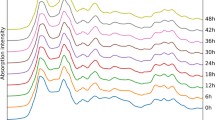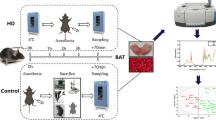Abstract
Postmortem diagnosis of extreme-weather-related deaths is a challenging forensic task. Here, we present a state-of-the-art study that employed attenuated total reflection (ATR) Fourier transform infrared (FTIR) spectroscopy in combination with Chemometrics for postmortem diagnosis of fatal hypothermia/hyperthermia by biochemical investigation of plasma in rats. The results of principal component analysis (PCA) and spectral analysis revealed that plasma samples from the fatal hypothermia, fatal hyperthermia, and control groups, are substantially different from each other based on the spectral variations associated with the lipid, carbohydrate and nucleic acid components. Two partial least squares-discriminant analysis (PLS-DA) classification models (hypothermia-nonhypothermia and hyperthermia-nonhyperthermia binary models) with a 100% accuracy rate were constructed. Subsequently, internal cross-validation was performed to assess the robustness of these two models, which resulted in 98.1 and 100% accuracy. Ultimately, classification predictions of 42 unknown plasma samples were performed by these two models, and both models achieved 100% accuracy. Additionally, our results demonstrated that hemolysis and postmortem hypothermic/hyperthermic effects did not weaken the prediction ability of these two classification models. In summary, this work demonstrates ATR-FTIR spectroscopy’s great potential for postmortem diagnosis of fatal hypothermia/hyperthermia.






Similar content being viewed by others
References
Hajat S, Kovats RS, Lachowycz K. Heat-related and cold-related deaths in England and Wales: who is at risk? Occup Environ Med. 2007;64:93–100.
Berko J, Ingram DD, Saha S, Parker JD. Deaths attributed to heat, cold, and other weather events in the United States, 2006–2010. National Health Statistics Reports 2014;76:1–15.
Lee W, Choi HM, Lee JY, Kim DH, Honda Y, Kim H. Temporal changes in mortality impacts of heat wave and cold spell in Korea and Japan. Environ Int. 2018;116:136–46.
Turk EE. Hypothermia. Forensic Sci Med Pathol. 2010;6:106–15.
Palmiere C, Mangin P. Hyperthermia and postmortem biochemical investigations. Int J Legal Med. 2013;127:93–102.
Doberentz E, Madea B. Microscopic examination of pituitary glands in cases of fatal accidental hypothermia. Forensic Sci Res. 2017;2:132–8.
Byard RW, Bright FM. Lethal hypothermia – a sometimes elusive diagnosis. Forensic Sci Med Pathol. 2018;14:421–3.
Maeda H. Forensic biochemistry for functional investigation of death: concept and practical application. Legal Med. 2011;13:55–67.
Palmiere C, Mangin P. Postmortem biochemical investigations in hypothermia fatalities. Int J Legal Med. 2013;127:267–76.
Palmiere C, Teresiński G, Hejna P. Postmortem diagnosis of hypothermia. Int J Legal Med. 2014;128:607–14.
Bańka K, Teresiński G, Buszewicz G. Free fatty acids as markers of death from hypothermia. Forensic Sci Int. 2014;234:79–85.
Bańka K, Teresiński G, Buszewicz G, Mądro R. Glucocorticosteroids as markers of death from hypothermia. Forensic Sci Int. 2013;229:60–5.
Pakanen L, Kaija H, Kortelainen ML, Särkioja T, Porvari K. Victims of lethal hypothermia have decreased levels of thrombomodulin in myocardium and urine. Int J Legal Med. 2015;129:289–96.
Yajima D, Asari M, Okuda K, Maseda C, Yamada H, Ichimaru C, et al. An objective approach using three indexes for determining fatal hypothermia due to cold exposure; statistical analysis of oxyhemoglobin saturation data. Legal Med. 2015;17:451–8.
Kaija H, Pakanen L, Uusitalo J, Nikkilä S, Kortelainen ML, Porvari KS. Changes in cardiac thrombomodulin and heat shock transcription factor 1 expression and peripheral thrombomodulin and catecholamines during hypothermia in rats. Stress. 2014;17:504–11.
Descloux E, Augsburger M, Teresiński G, Hejna P, Grouzmann E, Scarpelli MP, et al. Endocan concentrations in postmortem serum, vitreous humor and urine in victims of lethal hypothermia. J Forensic Legal Med. 2017;50:39–43.
Doberentz E, Markwerth P, Wagner R, Madea B. Expression of Hsp27 and Hsp70 and vacuolization in the pituitary glands in cases of fatal hypothermia. Forensic Sci Med Pathol. 2017;13:312–6.
Hervet T, Teresiński G, Hejna P, Descloux E, Grouzmann E, Palmiere C. Catecholamines and their O -methylated metabolites in vitreous humor in hypothermia cases. Forensic Sci Med Pathol. 2016;12:163–9.
Tauler R, Parastar H. Big (Bio)chemical data mining using chemometric methods: a need for chemists. Angew Chem Int Ed Engl. 2018. https://doi.org/10.1002/anie.201801134.
Kendall C, Isabelle M, Bazant-Hegemark F, Hutchings J, Orr L, Babrah J, et al. Vibrational spectroscopy: a clinical tool for cancer diagnostics. Analyst. 2009;134:1029–45.
Baker MJ, Hussain SR, Lovergne L, Untereiner V, Hughes C, Lukaszewski RA, et al. Developing and understanding biofluid vibrational spectroscopy: a critical review. Chem Soc Rev. 2015;45:1803–18.
Owens GL, Gajjar K, Trevisan J, Fogarty SW, Taylor SE, Da GRB, et al. Vibrational biospectroscopy coupled with multivariate analysis extracts potentially diagnostic features in blood plasma/serum of ovarian cancer patients. J Biophotonics. 2014;7:200–9.
Thumanu K, Sangrajrang S, Khuhaprema T, Kalalak A, Tanthanuch W, Pongpiachan S, et al. Diagnosis of liver cancer from blood sera using FTIR microspectroscopy: a preliminary study. J Biophotonics. 2014;7:222–31.
Ollesch J, Heinze M, Heise HM, Behrens T, Brüning T, Gerwert K. It's in your blood: spectral biomarker candidates for urinary bladder cancer from automated FTIR spectroscopy. J Biophotonics. 2014;7:210–21.
Sitole L, Steffens F, Krüger TPJ, Meyer D. Mid-ATR-FTIR spectroscopic profiling of HIV/AIDS sera for novel systems diagnostics in global health. OMICS. 2014;18:513–23.
Pizarro C, Estebandíez I, Arenzanarámila I, Gonzálezsáiz JM. Discrimination of patients with different serological evolution of HIV and co-infection with HCV using metabolic fingerprinting based on FT-IR. J Biophotonics. 2018;11:e20170035.
Paraskevaidi M, Clm M, Kmg L, Snowden JS, Saxon JA, Amt R, et al. Differential diagnosis of Alzheimer’s disease using spectrochemical analysis of blood. Proc Natl Acad Sci U S A. 2017;114:E7929.
Staniszewskaslezak E, Fedorowicz A, Kramkowski K, Leszczynska A, Chlopicki S, Baranska M, et al. Plasma biomarkers of pulmonary hypertension identified by Fourier transform infrared spectroscopy and principal component analysis. Analyst. 2015;140:2273–9.
Rai V, Mukherjee R, Routray A, Ghosh AK, Roy S, Ghosh BP, et al. Serum-based diagnostic prediction of oral submucous fibrosis using FTIR spectrometry. Spectrochim Acta A. 2017;189:322–9.
Corvec ML, Jezequel C, Monbet V, Fatih N, Charpentier F, Tariel H, et al. Mid-infrared spectroscopy of serum, a promising non-invasive method to assess prognosis in patients with ascites and cirrhosis. PLoS One. 2017;12:e0185997.
Staniszewska-Slezak E, Wiercigroch E, Fedorowicz A, Buczek E, Mateuszuk L, Baranska M, et al. A possible Fourier transform infrared-based plasma fingerprint of angiotensin-converting enzyme inhibitor-induced reversal of endothelial dysfunction in diabetic mice. J Biophotonics. 2018;11:e201700044.
Zimmermann B, Kohler A. Optimizing Savitzky-Golay parameters for improving spectral resolution and quantification in infrared spectroscopy. Appl Spectrosc. 2013;67:892–902.
Engel J, Gerretzen J, Szymańska E, Jansen JJ, Downey G, Blanchet L, et al. Breaking with trends in pre-processing? Trends Anal Chem. 2013;50:96–106.
Bro R, Smilde AK. Principal component analysis. Anal Methods. 2014;6:2812–31.
Ballabio D, Consonni V. Classification tools in chemistry. Part 1: linear models. PLS-DA. Anal Methods. 2013;5:3790–8.
Yonar D, Ocek L, Tiftikcioglu BI, Zorlu Y, Severcan F. Relapsing-remitting multiple sclerosis diagnosis from cerebrospinal fluids via Fourier transform infrared spectroscopy coupled with multivariate analysis. Sci Rep. 2018;8:1025.
Cakmak G, Miller LM, Zorlu F, Severcan F. Amifostine, a radioprotectant agent, protects rat brain tissue lipids against ionizing radiation induced damage: an FTIR microspectroscopic imaging study. Arch Biochem Biophys. 2012;520:67–73.
Stitt DM, Kastyak-Ibrahim MZ, Liao CR, Morrison J, Albensi BC, Gough KM. Tissue acquisition and storage associated oxidation considerations for FTIR microspectroscopic imaging of polyunsaturated fatty acids. Vib Spectrosc. 2012;60:16–22.
Adkins JN, Varnum SM, Auberry KJ, Moore RJ, Angell NH, Smith RD, et al. Toward a human blood serum proteome analysis by multidimensional separation coupled with mass spectrometry. Mol Cell Proteomics. 2002;1:947–55.
Pieper R, Gatlin CL, Makusky AJ, Russo PS, Schatz CR, Miller SS, et al. The human serum proteome: display of nearly 3700 chromatographically separated protein spots on two-dimensional electrophoresis gels and identification of 325 distinct proteins. Proteomics. 2010;3:1345–64.
Fuster V, Badimon L, Badimon JJ, Chesebro JH, Mair J, Morandell D, et al. Cardiac-specific troponin I levels to predict the risk of mortality in patients with acute coronary syndromes. N Engl J Med. 1996;335:1342–9.
Lin H, Luo Y, Sun Q, Zhang J, Tuo Y, Zhang Z, et al. Identification of pulmonary edema in forensic autopsy cases of sudden cardiac death using Fourier transform infrared microspectroscopy: a pilot study. Anal Chem. 2018;90:2708–15.
Bramanti E, Lenci F, Sgarbossa A. Effects of hypericin on the structure and aggregation properties of β-amyloid peptides. Eur Biophys J. 2010;39:1493–501.
Litvinov R, Faizullin D, Zuev Y, Weisel J. The α -Helix to β -sheet transition in stretched and compressed hydrated fibrin clots. Biophys J. 2012;103:1020–7.
Caine S, Heraud P, Tobin MJ, Mcnaughton D, Bernard CCA. The application of Fourier transform infrared microspectroscopy for the study of diseased central nervous system tissue. NeuroImage. 2012;59:3624–40.
Lin H, Luo Y, Wang L, Deng K, Sun Q, Fang R, et al. Identification of pulmonary edema in forensic autopsy cases of fatal anaphylactic shock using Fourier transform infrared microspectroscopy. Int J Legal Med. 2018;132:477–86.
Lin H, Zhang Y, Qi W, Bing L, Fan S, Wang Z. Species identification of bloodstains by ATR-FTIR spectroscopy: the effects of bloodstain age and the deposition environment. Int J Legal Med. 2018;132:667–74.
Wang Q, Li W, Liu R, Zhang K, Zhang H, Fan S, et al. Human and non-human bone identification using FTIR spectroscopy. Int J Legal Med. 2019;133:269–776.
Acknowledgements
This project was supported by grants from the National Key R&D Program of China (2016YFC0800702), the National Natural Science Foundation of China (81730056, 81722027, 81601645, and 81671869), and the Science and Technology Committee of Shanghai Municipality (17DZ2273200 and 19DZ2292700).
Author information
Authors and Affiliations
Corresponding authors
Ethics declarations
Conflict of interest
The authors declare that they have no conflict of interest.
Ethical approval
This study was approved by the Committee on the Ethics of Animal Experiments of Xi’an Jiaotong University and was conducted strictly according to the recommendations in the Guide for the Care and Use of Laboratory Animals of Xi’an Jiaotong University.
Additional information
Publisher’s note
Springer Nature remains neutral with regard to jurisdictional claims in published maps and institutional affiliations.
Rights and permissions
About this article
Cite this article
Lin, H., Zou, D., Luo, Y. et al. Postmortem diagnosis of fatal hypothermia/hyperthermia by spectrochemical analysis of plasma. Forensic Sci Med Pathol 15, 332–341 (2019). https://doi.org/10.1007/s12024-019-00111-8
Accepted:
Published:
Issue Date:
DOI: https://doi.org/10.1007/s12024-019-00111-8




